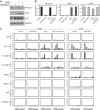A dual role for the histone methyltransferase PR-SET7/SETD8 and histone H4 lysine 20 monomethylation in the local regulation of RNA polymerase II pausing
- PMID: 24459145
- PMCID: PMC3953257
- DOI: 10.1074/jbc.M113.520783
A dual role for the histone methyltransferase PR-SET7/SETD8 and histone H4 lysine 20 monomethylation in the local regulation of RNA polymerase II pausing
Abstract
RNA polymerase II (Pol II) promoter-proximal pausing plays a critical role in postinitiation transcriptional regulation at many metazoan genes. We showed recently that histone H4 lysine 16 acetylation (H4K16Ac), mediated by the MSL complex, facilitates the release of paused Pol II. In contrast, H4 lysine 20 trimethylation (H4K20me3), mediated by SUV420H2, enforces Pol II pausing by inhibiting MSL recruitment. However, how the balance between H4K16Ac and H4K20me3 is locally regulated remains unclear. Here, we demonstrate that PR-SET7/SETD8, which monomethylates histone H4 lysine 20 (H4K20me1), controls both H4K16Ac and H4K20me3 and in doing so, regulates Pol II pausing dynamics. We find that PR-SET7-mediated H4K20me1 is necessary for the recruitment of the MSL complex, subsequent H4K16Ac, and release of Pol II into active elongation. Although dispensable for SUV420H2 recruitment, PR-SET7-mediated H4K20me1 is required for H4K20me3. Although depletion of SUV420H2 is sufficient to deplete H4K20me3 and relieve an H4K20me3-induced pause, pausing is maintained in the absence of PR-SET7 despite H4K20me3 depletion because of an inability to recruit the MSL complex in the absence of H4K20me1. These findings highlight the requirement for PR-SET7 and H4K20me1 in establishing both the H4K16Ac and H4K20me3 marks and point to a dual role in the local regulation of Pol II pausing.
Keywords: Chromatin Histone Modification; Chromatin Structure; Gene Regulation; H4K20me1; MSL Complex; PR-SET7/SETD8; RNA Polymerase; RNA Polymerase II Promoter-proximal Pausing; SUV420H2; Transcription Regulation.
Figures






Similar articles
-
SUV420H2-mediated H4K20 trimethylation enforces RNA polymerase II promoter-proximal pausing by blocking hMOF-dependent H4K16 acetylation.Mol Cell Biol. 2011 Apr;31(8):1594-609. doi: 10.1128/MCB.00524-10. Epub 2011 Feb 14. Mol Cell Biol. 2011. PMID: 21321083 Free PMC article.
-
PR-Set7-mediated monomethylation of histone H4 lysine 20 at specific genomic regions induces transcriptional repression.J Cell Biochem. 2010 Jun 1;110(3):609-19. doi: 10.1002/jcb.22570. J Cell Biochem. 2010. PMID: 20512922
-
Histone H4 lysine 20 methylation marks genes dynamically regulated during erythroid maturation.Epigenetics Chromatin. 2025 Jul 26;18(1):48. doi: 10.1186/s13072-025-00609-2. Epigenetics Chromatin. 2025. PMID: 40713835 Free PMC article.
-
[The biological functions of lysine methyltransferase PR-SET7].Yi Chuan. 2013 Mar;35(3):241-54. doi: 10.3724/sp.j.1005.2013.00241. Yi Chuan. 2013. PMID: 23575530 Review. Chinese.
-
PR-Set7 and H4K20me1: at the crossroads of genome integrity, cell cycle, chromosome condensation, and transcription.Genes Dev. 2012 Feb 15;26(4):325-37. doi: 10.1101/gad.177444.111. Genes Dev. 2012. PMID: 22345514 Free PMC article. Review.
Cited by
-
The TIP60 Complex Regulates Bivalent Chromatin Recognition by 53BP1 through Direct H4K20me Binding and H2AK15 Acetylation.Mol Cell. 2016 May 5;62(3):409-421. doi: 10.1016/j.molcel.2016.03.031. Mol Cell. 2016. PMID: 27153538 Free PMC article.
-
Histone H4 lysine 20 mono-methylation directly facilitates chromatin openness and promotes transcription of housekeeping genes.Nat Commun. 2021 Aug 20;12(1):4800. doi: 10.1038/s41467-021-25051-2. Nat Commun. 2021. PMID: 34417450 Free PMC article.
-
Salmonella enterica serovar Typhi exposure elicits ex vivo cell-type-specific epigenetic changes in human gut cells.Sci Rep. 2020 Aug 12;10(1):13581. doi: 10.1038/s41598-020-70492-2. Sci Rep. 2020. PMID: 32788681 Free PMC article.
-
Roles for the methyltransferase SETD8 in DNA damage repair.Clin Epigenetics. 2022 Mar 4;14(1):34. doi: 10.1186/s13148-022-01251-5. Clin Epigenetics. 2022. PMID: 35246238 Free PMC article. Review.
-
Drosophila melanogaster Set8 and L(3)mbt function in gene expression independently of histone H4 lysine 20 methylation.Genes Dev. 2024 Jun 25;38(9-10):455-472. doi: 10.1101/gad.351698.124. Genes Dev. 2024. PMID: 38866557 Free PMC article.
References
-
- Yamaguchi Y., Takagi T., Wada T., Yano K., Furuya A., Sugimoto S., Hasegawa J., Handa H. (1999) NELF, a multisubunit complex containing RD, cooperates with DSIF to repress RNA polymerase II elongation. Cell 97, 41–51 - PubMed
-
- Cheng B., Price D. H. (2007) Properties of RNA polymerase II elongation complexes before and after the P-TEFb-mediated transition into productive elongation. J. Biol. Chem. 282, 21901–21912 - PubMed
Publication types
MeSH terms
Substances
Grants and funding
LinkOut - more resources
Full Text Sources
Other Literature Sources
Research Materials

